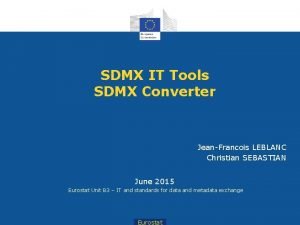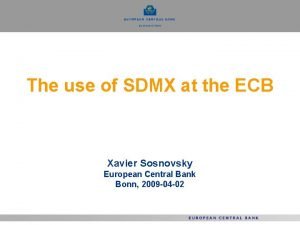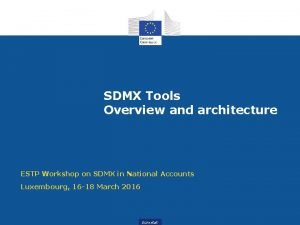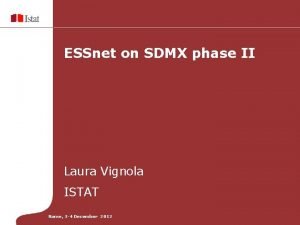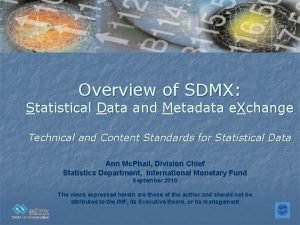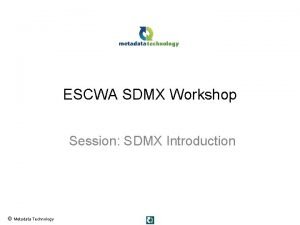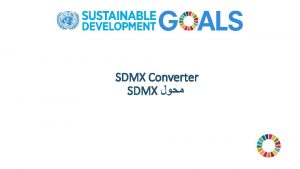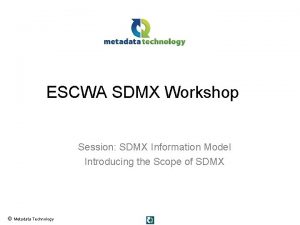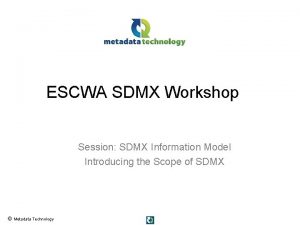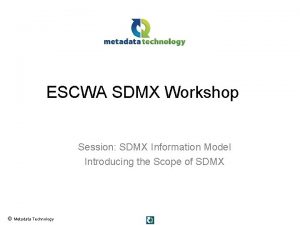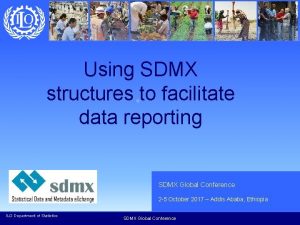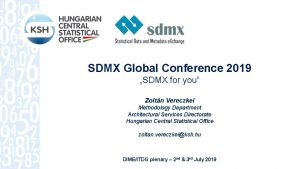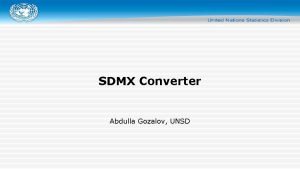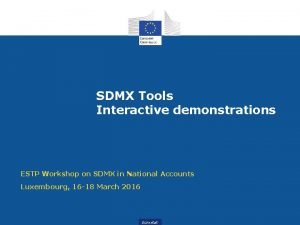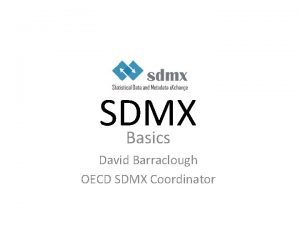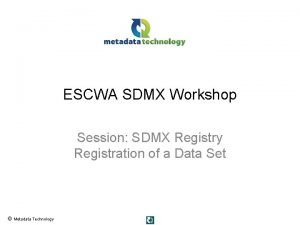11 The future of SDMX Introducing the SDMX














- Slides: 14

11. The future of SDMX Introducing the SDMX Roadmap 2020 ESTP Training Marco PELLEGRINO Eurostat, Unit B. 5 Data and Metadata Standards and Services Luxembourg, March 2017

SDMX Roadmap 2020 • Endorsed by the SDMX sponsors • High-level strategy, strategic context for future work • 4 priority areas for 2016 -2020: 1. Strengthening the implementation of SDMX 2. Making data usage easier via SDMX 3. Using SDMX to modernise statistical processes, as well as continuously improving the standards and IT infrastructure 4. Improving communication in general, including a better interaction between international partners 2

3 Eurostat

4 Eurostat

5 Eurostat

6 Eurostat

SDMX Actions (2016 -2018) SDMX Action Plan 2016 -2018 (https: //sdmx. org/? sdmx_news=sdmx-action-plan-2016 -2018 -implementing-the-roadmap-2020) At the beginning of 2016, the SDMX sponsors approved a "Roadmap 2020" presenting a vision of where SDMX is heading in the next few years and outlining a series of strategic objectives. These priorities are further developed in the present Action Plan covering the period until end of 2018. Each action is mapped to one of the four priority areas highlighted in the Roadmap, describing the work that can be deployed in a relatively short timeframe for: • Strengthening the implementation of SDMX • Making data usage easier via SDMX (especially for policy use) • Using SDMX to modernise statistical processes, as well as continuously improving the standards and IT infrastructure • Improving communication in general, including a better interaction between international partners The SDMX organisations will monitor the progress of these actions on an annual basis, in particular for identifying gaps in the current implementation program and for discussing priorities and resources needed to support the actions. The Action Plan will be updated yearly, based on a rolling calendar. 7

Reinforcing the SDMX business case • To improve the exchange of statistical data and metadata, which is complex, resource intensive and expensive • To provide a standardisation layer replacing or reconciling specific approaches and solutions • To take advantage of opportunities related to new technologies for machine to machine exchange In the ESS: 2007: Endorsement at ESS Committee 2008: UNSC recognition 2009 -2014: SDMX inserted in legal acts for data-metadata exchange 8 Eurostat

Eurostat: from the start-up phase… • Initial focus on data collection from countries • Shared DSDs with ESS countries for regular data exchange • SDMX-compliant reference metadata (ESMS, ESQRS, …) • DSDs for global use with international org. (ESA, Bo. P) • SDMX dissemination web services 9 Eurostat

SPECIFY NEEDS DESIGN BUILD COLLECT PROCESS ANALYSE DISSEMINATE EVALUATE SDMX-RI infrastructure enabling buy-in and use of web services for exposing data Exposed using Loaded in Data SDMX-RI DDB Web dissemination • • • Census Hub: opened in December 2014 32 countries connected (EU & EFTA) 30 using the SDMX-RI Census Hub Eurostat 10

SPECIFY NEEDS DESIGN BUILD COLLECT PROCESS ANALYSE DISSEMINATE EVALUATE http: //data. europa. eu/euodp/en/about SDMX for Linked Open Data • • Single point of access to a growing range of data from the institutions and other bodies of the EU, free to use and reuse. Innovative use. Transparency and accountability of EU institutions. Managed by the Publications Office of the European Union. EU's open data policy is the responsibility of the Directorate-General for Communications Networks, Content and Technology of the Commission. • Based on RDF (Resource Description Framework - a family of specifications published • Main RDF vocabulary for statistical data: → Data Cube Vocabulary (simplified version of the SDMX model covering data structures) • by W 3 C allowing for machine-actionable, semantically rich linking of things found on the Web) 11 Eurostat

SPECIFY NEEDS DESIGN BUILD PROCESS COLLECT ANALYSE DISSEMINATE EVALUATE …towards a maturity phase Standard metadata layer for the description and use of data and metadata throughout the process (broadening the scope) 12 Eurostat

• Mapping to other standards (RDF Linked Open Data, DDI, XBRL, Geo. Stat, …) • Better documentation and training • More guidelines on modelling • VTL-based Validation-Transformation services in SDMX (rule sets, queries, web services, information model, integration with GSIM, etc. ) • Better support for multiple measures in registers • Extending code lists • Modelling artefacts (fine-tuning) • Facilitating reference metadata exchange • Describing more formats (CSV, JSON) • … 13

SDMX Roadmap: The new vision Thanks for your attention! Marco. Pellegrino@ec. europa. eu 14 Eurostat
 Future perfect continuous and simple
Future perfect continuous and simple Future perfect time
Future perfect time Sdmx converter
Sdmx converter Website localization statistics
Website localization statistics Sdmx excel
Sdmx excel Sdmx istat
Sdmx istat Http://sdmx.us:8080
Http://sdmx.us:8080 Sdmx converter
Sdmx converter Future vs future perfect
Future vs future perfect Future plans and finished future actions
Future plans and finished future actions Continuous future in the past
Continuous future in the past Swing past participle
Swing past participle Future continuous vs future perfect
Future continuous vs future perfect Present continuous plans
Present continuous plans Future perfect future continuous exercises
Future perfect future continuous exercises


